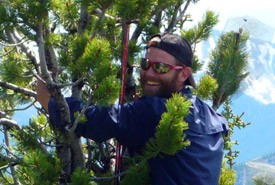Excerpt: Bracing for Change

Adrian Leslie, Darkwoods project manager (Photo by Adrienne Shaw)
By Allan Britnell
Sometimes conservation can be both thrilling and frightening. As part of his work in the Nature Conservancy of Canada’s (NCC’s) Darkwoods Conservation Area in southeastern British Columbia, Project Manager Adrian Leslie occasionally dons a harness and climbing ropes to scale to the tops of endangered whitebark pine trees to collect pinecones.
“One time I was buzzed by a golden eagle. It flew past about five feet above my head,” he recalls from the safety of his office in Nelson, BC. The raptor had a nest in a nearby cliff face. Another time, he noted fresh black bear claw marks in the trunk on the way up a tree. (Perhaps the bear had been after the same pinecones Leslie was.)
Leslie remains unscathed, but the same can’t be said for many of Canada’s once-pristine natural areas. With looming uncertainty over how climate change will impact our ecosystems, NCC’s landscape-scale approach to conservation is increasingly important to both ensure that our at-risk species survive today, and to help Canada’s species — including humans — better adapt as the climate continues to change. »
Pining for the forest
Whitebark pine is an endangered species in Canada, recently hit hard by a one-two pest punch from the native mountain pine beetle and the invasive white pine blister rust. This is bad news for more than just the tree. Its large, nutritious seeds make it a prime food source for a number of mammals and birds, including grizzlies, red squirrels and Clark’s nutcracker.
So Leslie and his colleagues collect seeds from the cones that grow in the uppermost branches of the trees to raise blister rust-resistant saplings for planting in subsequent years. Whitebark pine is currently only found
in the alpine and subalpine forests of BC and Alberta, at the northern edge of its range. But as the planet warms, this range will likely creep further north, pushing flora and fauna with it.
Healthy forests that can provide food sources and shelter for a variety of wildlife species will be essential to helping them survive and thrive in their future homes.
Protecting the prairies
Recently, NCC adapted a few of its natural area conservation plans to include climate change considerations — including the tall grass prairie natural area, where staff have already made changes in their land management practices to
account for a changing climate.
Want to read more?
Donate at least $25 and receive four issues of the Nature Conservancy of Canada Magazine.





